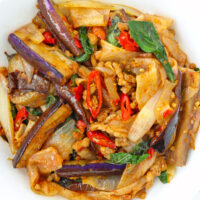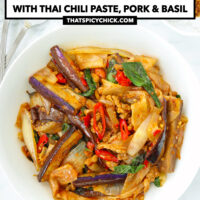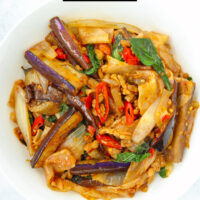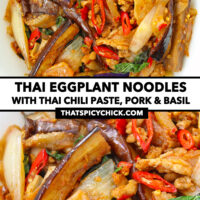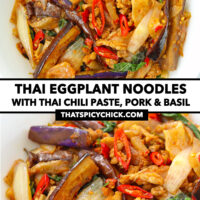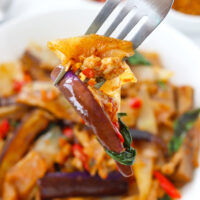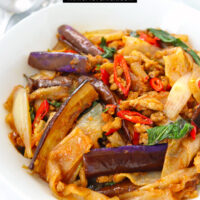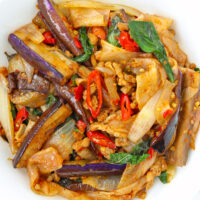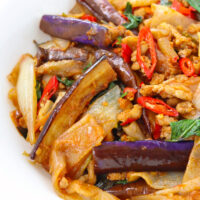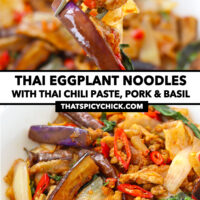 Buy Now →
Buy Now → Thai Eggplant Noodles (with Chili Paste, Pork & Basil)
Juicy eggplant strips, ground pork, garlic, chilies, and fragrant Thai sweet basil get tossed with fresh flat wide rice noodles in a mouthwatering sauce in this 30 minute Thai Eggplant Noodles!
- Prep Time: 15
- Cook Time: 15
- Total Time: 30 minutes
- Yield: 2 1x
- Category: Dinner
- Method: Stir-fry
- Cuisine: Thai
Ingredients
Scale
For the Sauce:
- 2 TBLS Thai Chili Paste/Chili Jam (Nam Prik Pao – note 1)
- 1 TBLS Oyster Sauce
- 1 TBLS Light Soy Sauce
- 1 TBLS Fish Sauce
- 1 TBLS Tamarind Paste (note 2)
- ½ TSP White Sugar
- 1 TBLS Water
For the Thai Eggplant Noodles:
- 350 grams / 12.35 ounces fresh Flat Wide Rice Noodles (note 3) – cut into 1-inch strips if using noodle sheets and not pre-sliced noodles
- 200 grams / 7 ounces Chinese or Japanese Eggplant – cut into 2-inch long and ¾-inch wide batons
- 1 TSP Kosher Salt
- 1 cup Thai Sweet Basil Leaves (note 4)
- 6 Garlic cloves – roughly chopped
- 2 – 10 fresh Red Chilies (Thai Bird’s Eye or any small hot red chilies – note 5), to taste – destemmed, roughly chopped
- 2 – 6 Prik Kee Nu Green Chilies (optional), to taste – destemmed, roughly chopped
- 1 Large Red Chili – deseeded if desired, thinly sliced at an angle
- ½ medium Yellow Onion – sliced into ¼-inch wide strips
- 3.5 TBLS Canola Oil (or other neutral oil with a high smoke point)
- 150 grams / 5.3 ounces lean Ground Pork
- ½ TSP ground White Pepper, divided
- To Serve (optional): Thai chili powder, fish sauce with chopped chilies (Prik Nam Pla)
Instructions
Prep:
- Make the sauce: Whisk together the Thai chili paste, oyster sauce, light soy sauce, fish sauce, tamarind paste, white sugar and water in a measuring cup (or small bowl) until combined well and set aside.
- Prepare the fresh wide rice noodles: If using sheets of fresh wide rice noodles that are not already pre-cut, cut or (or gently tear) into 1-inch wide strips. If they have been previously refrigerated, remove from the fridge 20-30 minutes (or warm for 20 seconds in microwave on high) before cutting/tearing.
- Prepare the fresh ingredients: Fill a medium bowl with water and stir in 1 TSP kosher salt. Slice the eggplant into 2-inch long and ¾-inch wide batons and transfer to the bowl. Allow to soak for 15-20 minutes. Pick the Thai sweet basil leaves off the stems and wash and pat-dry. Chop/slice the garlic, red chilies, prik kee nu green chilies (if using), large red chili, yellow onion as indicated in the ‘ingredients’ section. Using a mortar and pestle, pound the garlic, fresh Bird’s Eye red chilies and prik kee nu green chilies into a coarse paste and set aside. (Finely chop if you don’t own a mortar and pestle.) Drain the eggplant strips into a colander and pat-dry.
For the Thai Eggplant Noodles:
- Dry-fry the eggplant: Heat 1.5 tablespoons canola oil in a large wok (or deep heavy bottomed frying pan) over medium-high heat. Once hot, add the eggplant strips and cook for 6-7 minutes, tossing occasionally, until lightly browned and tender. Transfer to a clean bowl and set aside. (Don’t worry if the eggplant strips are not fully tender. The residual heat will allow them to continue cooking and become tender while they sit in the bowl.)
- Stir-fry the onion and aromatics: Heat the remaining 2 tablespoons of oil in the wok over high heat. Once hot, add the onion and stir-fry for 30-40 seconds until slightly softened. Add the smashed garlic and chilies paste and the large red chili slices. Stir-fry for 30 seconds until fragrant.
- Cook the pork: Add the ground pork and season with ¼ teaspoon ground white pepper. Cook for 1-2 minutes, breaking the clumps with your spatula, until no longer pink and just cooked.
- Add the noodles and sauce: Add the rice noodles and pour the sauce on top. Toss continuously until everything is evenly coated in the sauce.
- Season and toss through basil: Season with the remaining ¼ teaspoon ground white pepper and add the Thai sweet basil leaves. Toss for 15-20 seconds or until the basil has slightly wilted, then switch off the heat.
- To Serve: Divide evenly onto plates. Serve immediately while hot, with Thai chili powder and fish sauce with chopped chilies on the side if desired.
Notes
- Thai Chili Paste/Jam. This is a savory-sweet paste with the texture of jam. It’s made with soybean oil, dried shrimp, onion, garlic, dried chilies, tamarind, sugar, salt, and shrimp paste. Everything is blended together and then roasted in a pan before being packaged in small jars. It is also known as “roasted chili paste” or “roasted chili paste in soybean oil”, and ‘nam prik pao’ in Thai. Look for a jar in a Thai grocery store or Asian supermarket, or purchase it online. Avoid using too much of the oil in the jar and mainly use the paste to prevent the noodles from becoming too greasy. I recommend Mae Pranom brand, which is less sweet than Pantainorasingh (Pantai) brand Thai chili paste.
- Tamarind Paste. This is also called tamarind concentrate sometimes. It is a light brown paste made from tamarind and is sour and sweet in flavor. Some brands are more tangy than others, so you may need to adjust the amount you use accordingly. Make sure you use a Thai tamarind paste and not an Indian one. The latter is black and sticky and not what we need for this recipe. Look for it in the Asian aisle of large supermarkets that are well-stocked with international ingredients or in a Thai or Asian grocery stores. It is also available online.
- Flat Wide Rice Noodles. Fresh rice noodles have a lovely chewy and bouncy texture. They are made from rice flour, water, tapioca or corn starch and salt and are gluten-free. Look for them in the refrigerator section of an Asian supermarket or specialty noodles store. If substituting with dried wide rice noodles, prepare 150 grams / 5.3 ounces of noodles according to package instructions. Toss them with a bit of oil after draining to prevent them from sticking. Then use as indicated for this recipe.
- Thai Sweet Basil. These fragrant, sweet smelling leaves are known as ‘horapa’ in Thai. They add a wonderful anise-y flavor and sweet aroma to Thai curries and stir-fries. In terms of appearance, the leaves are glossy and smooth and they have purple flowers. Look for them at a specialty Thai ingredients store or Asian supermarket. Substitute with Thai holy basil or Italian basil if unavailable.
- Fresh Chilies. Any small hot red and green chilies that you can get in your area will work if you can’t get a hold of Thai Bird’s Eye and prik kee nu green chilies. Although the prik kee nu chilies are tiny in size, they are very hot. They can also be tricky to find outside of Asia so I’ve listed them as optional. You may also want to leave them out if you are sensitive to heat. Adjust the quantity of Bird’s Eye and prik kee nu chilies based on your spice level preference. The large red chili is mild and similar in taste to red bell pepper. It’s mainly used for color here. Omit it if you don’t have it on hand or substitute with sliced red bell pepper.
- See ‘Variations’ section in the post above to customize for specific diets.
Nutrition
- Serving Size: 1 serving
- Calories: 844
- Sugar: 26.6g
- Sodium: 1614.2mg
- Fat: 42.2g
- Saturated Fat: 10g
- Unsaturated Fat: 29.7g
- Trans Fat: 0.2g
- Carbohydrates: 95.8g
- Fiber: 7.8g
- Protein: 26.1g
- Cholesterol: 55.4mg
Find it online: https://thatspicychick.com/thai-eggplant-noodles/
